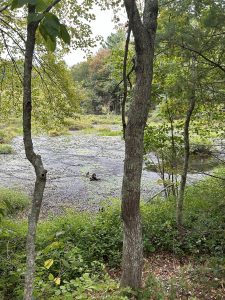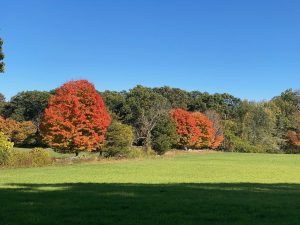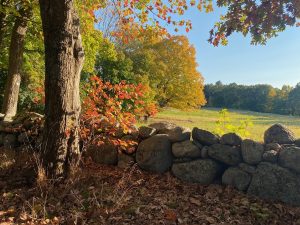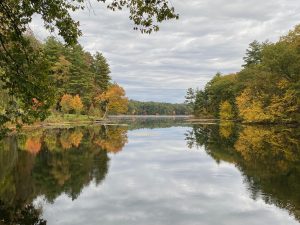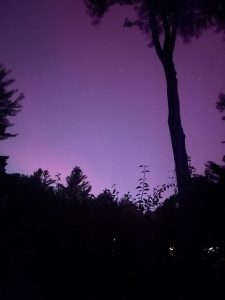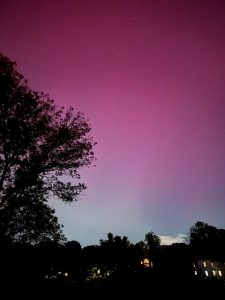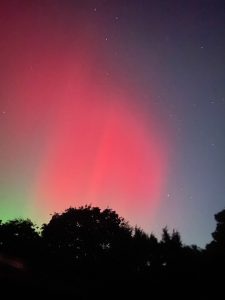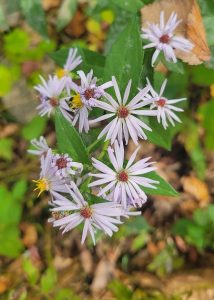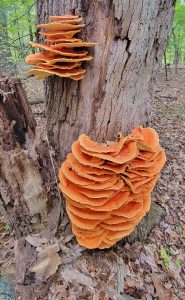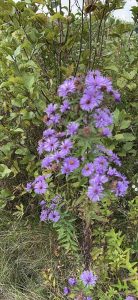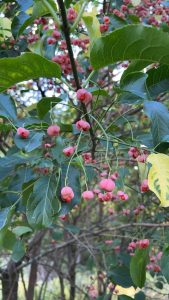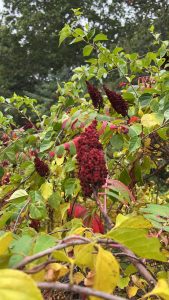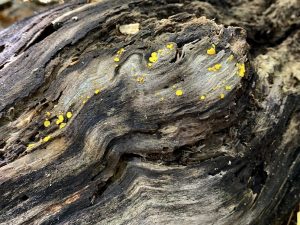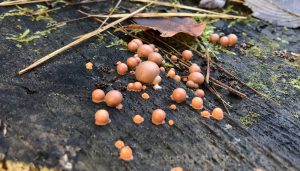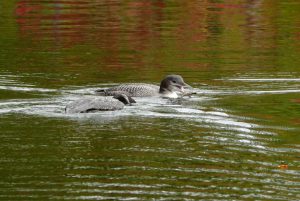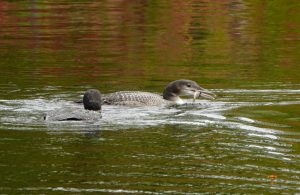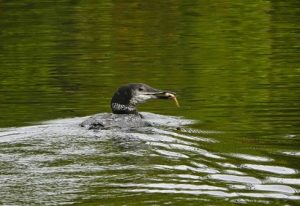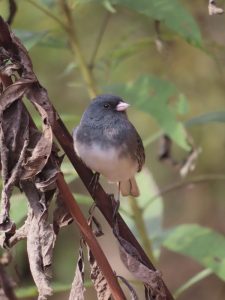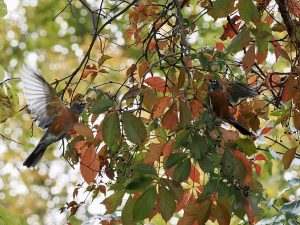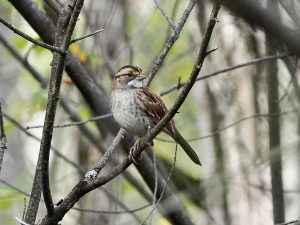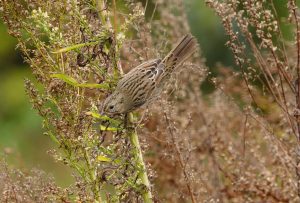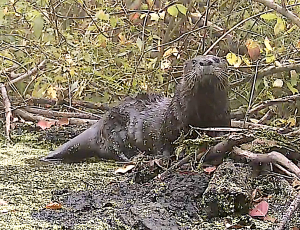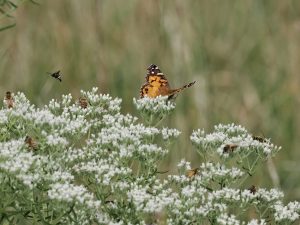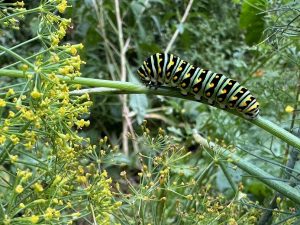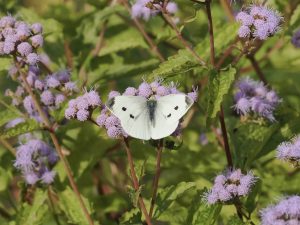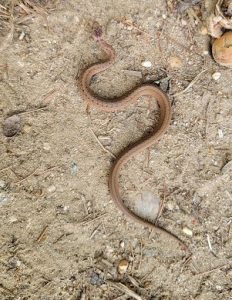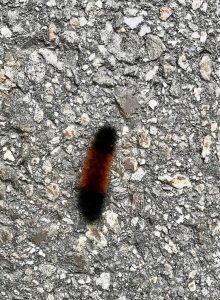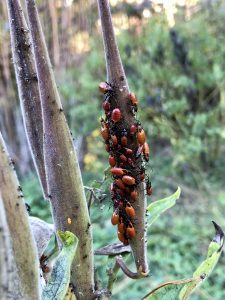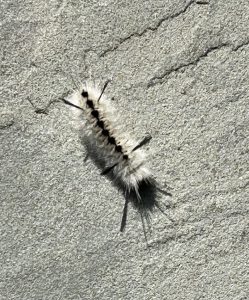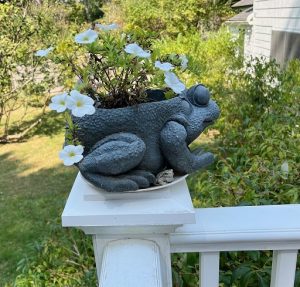Written by Gwyn Loud for the Lincoln Land Conservation Trust. She welcomes your sightings and questions at 781-259-8690 or gwynloud555@gmail.com
September and October, so far, have given us little precipitation, although welcome gentle rain on Sept. 22 broke a very long stretch with none. Now, as of Oct. 11, the state’s drought monitor map shows much of the northeastern and central parts of the state in “mild drought”. We see this in the low water level in ponds and streams and the powdery soil. I am happy to have rain falling as I write! Our local plant world needs a good soaking. Autumn’s brilliant fall colors are starting their bright display, prompted by the instigating conditions of chilly nights and warm days. Leaves of deciduous trees go through stages of senescence, losing chlorophyll and revealing the underlying carotenoids in the golden yellows, oranges, and reds whose beauty we treasure. In the interests of healthy soils and ecosystems, please consider “leaving the leaves”, at least many of them. Instead of removing every last fallen leaf to look “tidy”, allow the leaves to decompose, “to provide habitat for overwintering insects, deposit nutrients and carbon into the soil, and regulate soil temperature and moisture”, to quote an LLCT Seasonal Reference Guide related to biodiversity and climate change. Leaving plant stems standing in flower beds is also beneficial.
Do evergreens drop their needles? Yes, they do. My own driveway happens to be covered in brown white pine needles right now. According to a post from Russell Tree Experts, “Yellowing and the loss of old needles in the fall is normal for pine, spruce, arborvitae, hemlock and most evergreen conifers…..Most conifers shed needles each year starting in late August and continue through November. Older interior needles will turn yellow while needles further out in the canopy and at the tips of branches will stay green. The yellow needles eventually drop off starting at the top of the tree and working their way to the bottom in a uniform fashion.”
The bounty of wild food continues this month in the form of berries and seeds and it is obviously a huge mast year, judging by the plentitude of acorns. We shudder at the thought of eating poison ivy but many birds and mammals find meals in the fruits. As Mary Holland writes, “The fruits, called drupes, are a source of sustenance for over 60 species of birds. They are particularly sought after by Gray Catbirds, Northern Flickers, Kinglets, Hermit Thrushes and Downy Woodpeckers. Although many birds consume the fruit of Poison Ivy, it is low-quality in that it has very few lipids, or fatty compounds. Migrating birds in the fall eat some of the berries; however, they feed mostly on high-quality fruits, those with high lipid content. Most of poison ivy’s fruit is consumed by resident birds in the winter, when other food is scarce….White-tailed Deer, Black Bears, Muskrats and rabbits also eat the fruit, stems and leaves of poison ivy.”
American asters (white) are still flowering, as is the spectacular purple New England aster, both species favorites with bees. While admiring some staghorn sumac on Hawk Hill Rd. I came across several spindle bushes, a European form of euonymus. Fungi and slime molds (now known to be unrelated to fungi) are also to be found at this season and can be quite colorful, with interesting shapes. Carol Roede wrote, “I love how the slime molds appear out of nowhere after rain. This was the first time I’d seen Wolf’s Milk when it was still pink and fresh. Usually I come across them later, when they’re dry and releasing spores.”
This year birding history was made with the first successful nesting of Common Loons on Flint’s Pond since, possibly, the 1800’s. Nearby residents and Water Department staff have heard the calls of Common Loons on Flint’s Pond for several summers. Last summer one of the water operators was startled to see a female loon on the island sitting on an old Canada goose nest, incubating two eggs which did not hatch. This year one of her eggs hatched and at this late date the chick is now almost as big as its parents. In late fall the adults migrate to coastal waters, leaving their chick behind but it will follow before first freeze-up.
In 1975 a nesting pair was found on the Quabbin Reservoir after almost a century’s absence in Massachusetts for this species. The Flint’s Pond fledging marks a new Eastern frontier in the state for breeding success. A female is faithful to a nesting site so we expect she will return next year. The State Ornithologist, Dr. Andrew Vitz, has asked Norman Levey to monitor the loons on Flint’s going forward. Check out the link below to see Norm’s video of the female feeding her now-large chick.
As bird migration winds down, the avian travelers are fattening up for the trip. Some go only as far as the mid-Atlantic states, others fly to Central America, and several make very impressive journeys. Bobolinks, for example, fly 12,500 miles round trip to winter in South America. Blackpoll warblers, which breed in the boreal forest, have the longest migration of any North American warbler. “Each fall, most Blackpolls migrate more than 2,000 miles across open water without stopping, sometimes flying for more than 80 hours straight until they reach their Amazon wintering grounds” according to the American Bird Conservancy.
October is living up to its reputation as “sparrow month”. Weedy places, such as the Food Project and Ricci fields can produce good numbers of sparrows; one day a birder counted 65 Savannah sparrows, and other sparrow species seen around town were Lincoln, white-throated, chipping, song, swamp, field, and two unusual ones: clay-colored and vesper. Drumlin Farm, with its varied habitats, has been very birdy this fall, with sightings of two dickcissels, lots of killdeer, American pipits, Wilson’s snipe, golden-crowned and ruby-crowned kinglets, blue-headed and red-eyed vireos, flocks of cedar waxwings, and warblers such as palm, pine, yellow-rumped, black-throated green, black-throated blue, common yellow-throats, and many blackpoll.
Birders have spotted large flocks of common grackles and migrating flocks of bobolinks; Norm Levey captured some feeding amongst Mexican sunflowers on video (see link). Other avian reports of note include a hermit thrush, a hooded warbler, a winter wren, an Eastern towhee, Virginia rails, and a great-blue heron, which is a regular by the Pierce Park Pond. Three bald eagles were soaring high above Dakin Field, probably the adults with one immature from the nest on Fairhaven Bay.
If you feed the birds, it is wise to set up your feeders by the end of the month so that the birds get your ‘restaurant’ built into their routine. Winter visitors such as dark-eyed juncos and white-throated sparrows have just arrived, and I have been happy to have a red-breasted nuthatch enjoying sunflower seed. A citizen-science project called Project Feeder Watch is an easy and enjoyable way to observe the birds at your feeder while also contributing to gathering data about bird populations. See link to learn more and how to join.
In the world of mammals, woodchucks, true hibernators, are preparing to hunker down in their tunnels for the winter. Eastern chipmunks are still dashing about and collecting food, but they will go underground for the winter too, taking long naps and sometimes emerging on a warm winter thaw. A Police Department report from Canaan Drive mentioned a resident’s discovery of several young opossums and Carol Roede’s trail cam video also showed opossums, as well as coyote, fisher, an occasional bobcat, and raccoon kits, getting big but still going around with an adult. In addition, the trail cam shows an otter scent marking on a spot which which beavers and muskrats pass through every night. Otters have scent glands all over their body and they also mark as they urinate and defecate. A weasel, in perfect condition, was found dead on the roadside along Weston Rd. Kathleen Lomatoski, the observer, wrote, “I often wonder when I find deceased animals that look nearly perfect if they ingested poison or ate animals who had done so.” Rodenticides are a big problem in the food chain, killing predators, such as raptors, owls, and mammals who have eaten smaller prey such as mice or rats which have died slowly from rodenticides. Please do not use rodenticides around your homes or outbuildings.
Insects such as crickets and katydids have continued to be heard on mild days and evenings this month. You may find field crickets in your house as cold weather comes, but they are not harmful. Observers have seen some late-migrating monarch butterflies and scientists in New Hampshire have been surprised at the delay, which may be weather-related. Insects which remain here in the winter, go into a resting period called diapause, triggered by diminishing hours of daylight and falling temperatures. During diapause respiratory and metabolic rates are low and slow. Ice crystals in the adult’s body could be lethal, so, as a post from the Vermont Center for Ecostudies explains, “To keep from freezing, butterflies reduce the amount of water in their blood (White Admiral caterpillars reduce the amount of water in their body by 30 percent) and thicken it with glycerol, sorbitol or other antifreeze agents. These chemicals function much like the antifreeze we pour into our car radiators.” Some insects rest in protected places such as under rocks or bark, others go underground where the temperature is warmer than the air. Others overwinter as eggs or larvae. When we see birds such as woodpeckers tapping on trees in the winter, they are hunting for insects which are hiding. I have seen more woolly bear caterpillars than usual this fall; they spend the winter curled up in protected places and wait until spring to make a white fuzzy cocoon, then emerge as an Isabella tiger moth. Many adult butterflies and moths lay eggs before winter, then die, but others overwinter as pupae. A Beaver Pond Road resident was surprised to find a beautiful black swallowtail caterpillar feeding on dill as late as October 7. It will overwinter as a chrysalis.
Frogs have been active during recent summer-like days and still call or trill sporadically. Spring peepers have actually been heard in every month of the year, although only in big choruses in the spring. A Sunnyside Lane resident has been watching a gray treefrog which returns often to a protected spot it seems to favor, under a plastic frog planter! Will Leona, on our Conservation Dept. staff came across a Dekay’s Brownsnake, which are common but not well-known as they are secretive and nocturnal. As Mary Holland writes, “While most snakes (70%) are oviparous, or egg-layers, DeKay’s Brownsnakes are in the minority and give birth to live young (viviparous) in late summer. About 4” at birth, these non-venomous snakes average only about a foot long when fully grown and are often thought to be juvenile snakes due to their size……..they feed on slugs, snails and earthworms. (Their teeth lack sockets and are fixed to the ridge of their jaw, allowing the snake to remove a snail from its shell.” Looking skyward, some lucky viewers, such as a Hillside Rd. resident, saw the recent display of Northern Lights on October 10 (I looked in vain the next night). 2024 has been a very active year for viewing the aurora events, which occur when the Sun is in the most active part of its 11-year cycle. Astronomers predict that we will have more opportunities to see the Northern Lights. I hope so!
Links
To see Norm Levey’s video of the female Loon feeding her now-large chick
To see Norm Levey’s video of Bobolinks
To learn about Project Feeder Watch
To see Carol Roede’s wildlife cam footage of otters


